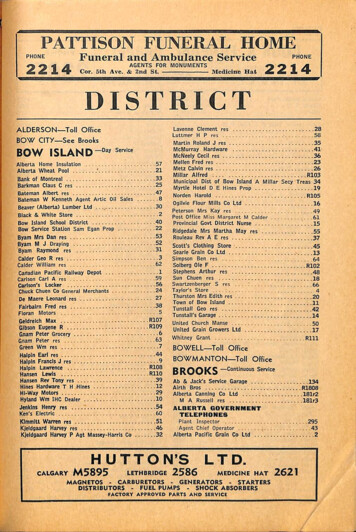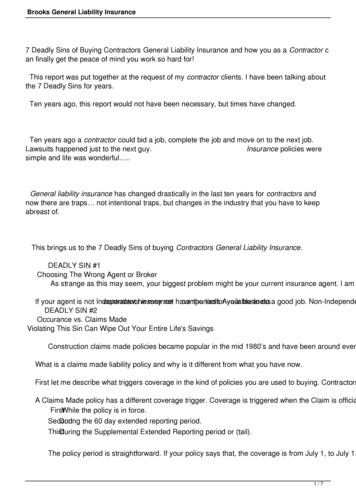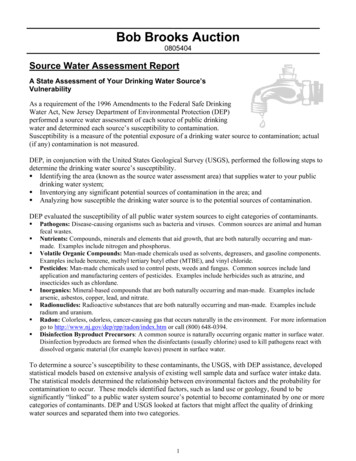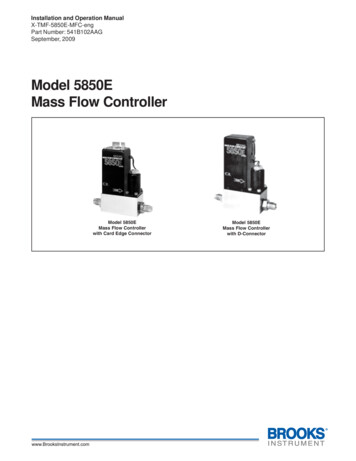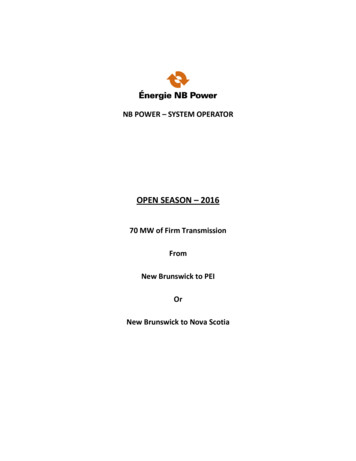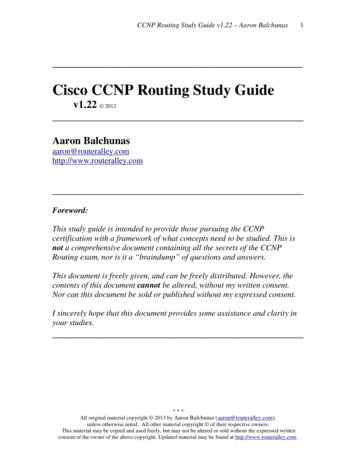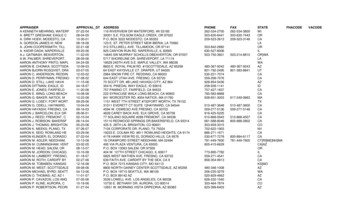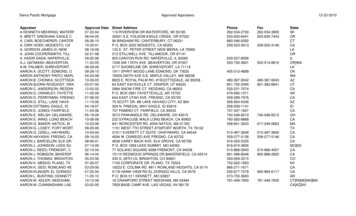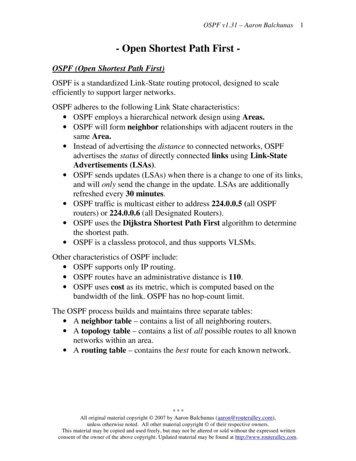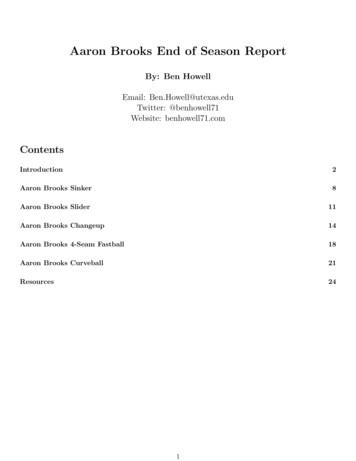
Transcription
Aaron Brooks End of Season ReportBy: Ben HowellEmail: Ben.Howell@utexas.eduTwitter: @benhowell71Website: benhowell71.comContentsIntroduction2Aaron Brooks Sinker8Aaron Brooks Slider11Aaron Brooks Changeup14Aaron Brooks 4-Seam Fastball18Aaron Brooks Curveball21Resources241
IntroductionIn his first season for the Kia Tigers, Aaron Brooks displayed excellent control and usage of his three mainpitches, a sinker, slider, and changeup, with an intriguing approach with his curveball. He was the bestpitcher in the KBO, with top three swinging strike numbers, as well as being the best ground ball pitcherin the league. He displayed the ability to mix and match approaches, with pitches that neutralized bothRHH and LHH. It was an impressive performance from Brooks and one that I believe positions him wellto make a successful return to Major League Baseball.Based on his revamped swing and miss stuff and ability to induce ground balls, I believe that Aaron Brookscan succeed in MLB, similarly to Merrill Kelly, with the Arizona Diamondbacks, and Kwang Hyun-kim,with the St. Louis Cardinals, who have recently gone from the KBO to MLB.VitalsThrows: RHPAge: 30DOB: 4/27/1990Height: 6’ 4"Weight: 229 lbsPitch TypeAvg 84.693.680.240.3%23.4%20.7%8.8%6.8%2
Pitch Locations for Aaron Brooks. Data for 1484 pitches from June 4th and June 28th to September 19thstarts manually charted from KBO Twitch and ESPN Broadcasts.Pitcher PerspectiveLHHRHHfeet above home plate6Pitch44 SeamChangeupCurveballSinker2Slider0 2 1012 2 1012feet from home plateStats from FanGraphs for entire season (2218 pitches, 151.1 IP) for Aaron BrooksSeasonTeamK%2020 Kia TigersBB%22.2% 4.1%K-BB%AVGWHIP18.1%0.2341.02BABIPLOB%ERA0.299 75.5%FIP2.5 2.72Overall Charted Stats for Aaron 417.231.127.551.446.975.278.0Overall Charted Batted Ball Event Data for Aaron 644.830.140.840.814.429.232.534.443.142.324.423.23
Brooks Velocity DistributionSinker 92, Slider 87, Changeup 85, 4 Seam 94, Curveball 80200150Pitchcount4 elocityPitch Type Charted Stats for Aaron BrooksPitchVelocityUsg Changeup4-SeamCurveballPitch Type Charted Batted Ball Data for Aaron cityUsg .121.711.14
Aaron Brooks Charted BBE PlotData for charted BBEs from 9/03 to Present 50BBEs0.025 1000.0200.0150.010 1500.005 20050100150200Pulled from KBO on ESPN/Twitch broadcastsAaron Brooks, a 30-year-old RHP with 170.2 IP of MLB experience split between the Kansas City Royals,Oakland Athletics, and Baltimore Orioles, made the jump to the Korean Baseball Organization (KBO) in2020, pitching for the KIA Tigers. Brooks established himself as the best pitcher in the league in 2020,displaying good swing and miss stuff as well as doing an excellent job of killing hard contact and keepingthe ball on the ground. Brooks’ season came to an early end when he returned to the States to be withhis family following an accident.Brooks threw five different pitches in the KBO, the same five he threw in MLB action. His primary pitchis his sinker, which comes in around 92.3 mph, but can get up to 95 mph. He also throws a 4-Seamfastball at a much lower rate, which comes in around 93.6 mph, again touching 95-96 mph when he wantsto push it for a swing and miss. His slider serves as his primary swing and miss pitch with a 23.7%SwStr% and averages about 86.6 mph. Brooks’ changeup, almost exclusively a weapon against LHH,averages about 84.6 mph but has been up to about 86-87 mph at times with some pretty impressivevertical drop and horizontal movement. His fifth pitch is his curveball, coming in around 80.2 mph, but herarely throws it, only using it in one certain situation.As he’s transitioned to the KBO, Brooks has made a few adjustments to his pitching approach. Mostnotably, he’s seen his velocity tick up by 1-2 mph on most of his pitches. His Sinker went from 91.8 mphto 92.3 mph, his Slider went from 85.6 mph to 86.6 mph, his Changeup stayed around 84.7 mph, hisCurveball jumped from 78.6 mph to 80.2 mph, and his 4-Seam jumped from 92 mph to 93.6 mph. Thosearen’t huge differences on average, but at 30 years old, it’s notable, especially with his fastballs trendinghigher than when he was in MLB, where his FB velocity was in just the 34th percentile.He also altered his pitch usage, throwing his sinker 40.3% of the time and dropping his 4-Seam usage toabout 8.8%, a drastic change from his 28% sinker%, and 25.7% 4-seam% during his last MLB stint in2019. His slider and changeup usage% stayed relatively even, but he compensated for that extra room by5
doubling his curveball% up to 6.8%. His curveball usage has been interesting because a lot of it has comein 0-0 counts; against LHH, throwing early curveballs helps steal a first-pitch strike, while and againstRHH it serves to set up his slider/sinker.Aaron Brooks Pitch Usage by Batter Handedness and .912.78.67.818.61.49.520.23.90.02.73.2RHH 12RHH 20RHH 21RHH 22RHH 0RHH 31RHH Sinker%Slider%Changeup%4-Seam%Curveball%LHH 00LHH 01LHH 02LHH 10LHH 7.9LHH 12LHH 20LHH 21LHH 22LHH 0LHH 322544.020.024.012.00.0SideCountOver 151.1 IP, Brooks posted a 2.50 ERA (2nd in the KBO) and a FIP of 2.72 (1st in the KBO). His22.2% K% and WHIP of 1.02 ranked 2nd in the KBO, while his BB% of 4.1% and K-BB% of 18.1% werethe third-lowest marks in the KBO. Brooks established himself as an excellent strike-thrower with Kia,with a 69.8% Strike% (1st) and a 65.7% First-pitch strike% that is a marked improvement over his MLBcareer F-Strike% of 60.5%. Over the 399 at-bats that I saw Brooks pitch, he faced a 3-0 count just 5times, each coming against RHH, signaling his ability to throw strikes and induce advantageous contact.Brooks’ whiff% jumped from 19% in MLB to 24.8% in the KBO, despite the KBO average whiff% of21.8% over 25000 pitches ranking a few points below the MLB average of 24.5%. His 12.7% SwStr%would rank 15th in MLB over the last two seasons, slotting right behind Charlie Morton and ahead ofGerman Marquez, Noah Syndergaard, and Trevor Bauer. His 31.1% Called Strike Whiff% (CSW%),6
ranks first in the KBO and would slot in at 17th in MLB over the last two seasons, tied with StephenStrasburg and just ahead of Charlie Morton.Brooks has made tangible improvements to increase his swing and miss stuff, with his numbers showingthat improvement even in a league with lower strikeout numbers than MLB. However, Brooks’ callingcard and biggest strength remain his ability to get ground balls and eliminate hard contact. His GB%,over 295 BBEs, was 72.5%, the best in the KBO, and over 20 points higher than the average KBO GB%,with another 7.1% of his BBEs allowed resulting in easy pop-ups. His hard contact% of 14.4% isminuscule, the lowest in the KBO. The best GB% in MLB over the last two seasons belongs to LuisCastillo at 56.1%, which is far below Brooks’ 72.5% GB% in the KBO; some of that is partly due todiffering hitter approaches, but a lot of it remains Brooks’ approach and attack plan.Aaron Brooks Pitch Usage by Batter 16.47.46.2His slider is his best swing and miss weapon, against both RHH and LHH (while still maintaining a GB%of 60.8%). He primarily uses his sinker and changeup as groundball pitches, with his changeup almostexclusively used against LHH. His changeup is a phenomenal ground ball weapon, with a GB%of 90.3% and soft contact% of 49.3%, both marks that top individual KBO pitches. Brooks’ sinkerranks 2nd in each of those categories, with a GB% of 69.3% and soft contact% of 44.3%.Aaron Brooks had some of the most remarkable performances in the KBO this season. Against theHanwha Eagles, he induced 26 whiffs and got 11 called strikes on 94 pitches, a stellar 39.4% CSW%. Hehas 6 of the top 7 games in terms of total groundouts, with his 17 groundouts against the Samsung Lionson September 1st leading the way. He’s also tied for the most called strikes in a game, netting 28 onAugust 23rd against the Kiwoom Heroes. He had multiple eight-inning, 1 run starts and was an extremelyreliable workhorse for the Tigers, averaging 6.2 IP per start. It was a remarkable run for Brooks,showing control over all his pitches and what makes them special.7
Aaron Brooks SinkerSwinging StrikesLHHRHHfeet above home plate6ndensity41.000.750.500.2520 2 1012 2 1012feet from home plateCalled StrikesLHHRHHfeet above home plate6ndensity41.000.750.500.2520 2 1012 2 1feet from home plate8012
Sinker Velocity200Avg Sinker: 92.3 mphcount150Pitch Type100Sinker5008890929496VelocityAaron Brooks Sinker StatsPitchVelocityUsg .340.359767.817.18.219.928.147.982.9SinkerAaron Brooks Sinker BBEsPitchSinkerVelocityUsg 7.99.644.340.615.1Aaron Brooks’ main pitch is his sinker, which he throws around 40% of the time at about 92.3 mph. In2019, with the Baltimore Orioles and Oakland Athletics, he threw it just 28% of the time and at 91.8mph. Trackman numbers for his KBO stint are hard to come by publicly, but in 2019, his sinker averaged17.2 inches of horizontal movement, 2.7 more than average, or 19% more. Based on what I saw over thenearly 600 sinkers that I saw Brooks throw, there was no indication that his sinker is moving any less inthe KBO.His sinker locations reflect that; his sinker is primarily for getting called strikes early in the count andground balls later. His sinker called strike hotspots are inside to LHH and away from RHH, utilizing thelate arm side break that his sinker creates to get called strikes and takes. Of his main pitches (sinker,slider, changeup), his sinker has the highest CS% of 19.9%. His sinker frequently starts outside of thestrike zone before it breaks late and catches the edge of the strike zone. It’s his go-to pitch when he needsa strike, illustrated by his heavy use of it hitters counts, like 2-0, 3-1, 3-2 counts.9
He does an excellent job of keeping his sinker up in the zone, working it on the up-and-in & up-and-awaycorners against both RHH and LHH where he gets swinging strikes. Coming in a 92-94 mph with 17inches of horizontal movement, nobody else in the KBO throws a comparable pitch, part of the reasonthat his whiff% on his sinker has jumped to 17.1%, nearly doubling the 8.8% whiff% it had in MLB.Sinker Stats by Batter .926.430.151.643.784.181.1Locating heavily on the edge of the zone, both inside and outside is a big reason that his sinker has beenable to induce such favorable contact. That 17 inches of horizontal movement either induces a lateswing as the hitter realizes the ball is tracking to be a strike or it jams the hitter/goes off the end of thebat (depending on LHH vs RHH), hence his GB% of 69.3% on his sinker, the second-highest GB% of anypitch in the KBO, only behind his changeup.He throws his sinker only about 38% of the time against LHH vs about 43% of the time against RHH; it’sa small difference in usage but, when combined with the movement of the pitch that dives away fromLHH, I believe that accounts for the (slight) differences in whiff%. However, RHH swing more frequentlyat his sinker so it has an equal 8.2% SwStr% against both RHH and LHH.Aaron Brooks’ sinker is a very good pitch, with a stellar combination of location and ability to induce softcontact. Against MLB hitters, I’d look for his sinker usage to remain pretty similar to the way that heused it, keeping it up in the zone against working inside against RHH and away from LHH.10
Aaron Brooks SliderSwinging StrikesLHHRHHfeet above home plate6ndensity41.000.750.500.2520 2 1012 2 1012feet from home plateCalled StrikesLHHRHHfeet above home plate6ndensity41.000.750.500.2520 2 1012 2 1feet from home plate11012
Slider VelocityAvg Slider: 86.6 mphcount75Pitch Type50Slider250808590VelocityAaron Brooks Slider StatsPitchVelocityUsg ider86.623.434677.736.623.71336.764.763.4Aaron Brooks Slider Stats by Batter 10.435.139.362.668.167.457.6Aaron Brooks Slider BBEsPitchVelocityUsg 820.39.59.541.442.915.7Aaron Brooks’ slider is arguably the best pitch in the KBO; at the very least it is in the conversation withDan Straily’s slider and Koo Chang-mo’s splitter. It’s a phenomenal weapon with multiple uses and heuses it well against both RHH and LHH. In MLB, his slider didn’t move very much, with his slider’s mosteffective season coming in 2019 when it averaged 36 inches of drop and just 1.5 inches of horizontalmovement. Off of the eye test, that looks similar to the 12-6 movement Brooks has gotten in the KBO,12
inducing vertical drop, but not much side-to-side movement. Fortunately, that works really well for himbecause it’s distinct from his sinker and changeup. With both of those pitches breaking so much arm side,something that doesn’t move much horizontally can be just as tough to get a read on. At 86-87 mph, hisslider comes in fast and has multiple uses against LHH and RHH.The most impressive thing about his slider is the sheer number of swings and misses that it induces. Awhiff% of 42.4% against LHH and 32.6% against RHH combine for a 36.6% whiff%, a few points about his33.7% whiff% on his slider in 2019 in MLB action. But that translates into a KBO pitch-type leadingswinging strike% of 23.7%, thanks to a ridiculous 64.7% swing%. So, not only does it miss bats whenhitters swing at it, but it’s deceptive enough and works wonderfully with his other pitches to get moreswings than any other pitch in the KBO.Against RHH, Brooks throws his slider about 28% of the time, usually locating down and away fromhitters. He gets most of his swinging strikes on his slider against RHH below the zone, while he sometimesgoes for the edge of the zone, getting called strikes as well. He’s confident in his ability to throw his sliderfor a strike whenever he needs to, evidenced by his 77.7% strike% and his willingness to throw it in anysituation. He throws it in 0-2 counts 35.7% of the time against RHH, but also 38.4% of the time in 1-0counts.Throwing his slider so much against RHH decreases the % of whiffs that he could get, but he compensateswith getting a solid 14.7% CS% on his slider against RHH. Almost all of the sliders that he throws againstRHH are on the outside edge of the zone, whether it’s up and in the zone for a called strike or down for aswing and miss.His approach shifts against LHH; most of his slider usage against LHH comes in 0-2 counts (30.2% usage),1-2 counts (27.4%), and 2-2 counts (36.2%). That’s because he likes to use his slider as a put-away pitchagainst LHH, which works because he throws his changeup heavily against LHH. With his sinker usagerelatively stable against LHH and RHH, that leaves fewer situations to throw his slider, which increasesits effectiveness immensely.Against LHH, Aaron Brooks only throws his slider about 18.3% of the time, but gets a strike 78.5% of thetime, with a whiff% of 42.4% and swinging strike% of 28.9% (42.4% is the same whiff% that Gerrit Colehad on his slider in 2020, on 24.7% usage). LHH receive a steady dose of backfoot sliders and insidesliders for called strikes.As with everything Aaron Brooks throws, his slider is a fantastic contact killer, which brings everythingtogether. Relative to his changeup and sinker, a 60.8% GB% might be considered low, but it’s still the9th best GB% on an individual pitch. It’s really hard to find a flaw with Aaron Brooks’ slider and it’susage this season in the KBO. Projecting forward, against MLB hitters, I don’t think there’s much ofanything to change with this pitch. It’s work phenomenally with his sinker and changeup and is anextremely effective swing-and-miss pitch with its usage of 23.4%.13
Aaron Brooks ChangeupSwinging StrikesLHHRHHfeet above home plate6ndensity41.000.750.500.2520 2 1012 2 1012feet from home plateCalled StrikesLHHRHHfeet above home plate6ndensity41.000.750.500.2520 2 1012 2 1feet from home plate14012
Changeup VelocityAvg Changeup: 84.6 mph100countPitch TypeChangeup50082848688VelocityAaron Brooks Changeup StatsPitchVelocityUsg .620.730769.425.813.716.33053.174.2ChangeupAaron Brooks Changeup Stats by Batter 14.131.026.953.352.673.875.6Aaron Brooks Changeup BBEsPitchChangeupVelocityUsg 9049.340.610.1Aaron Brooks’ slider has been special in 2020, but his changeup deserves just as much as attention as aone of a kind type pitch in the KBO. Brooks uses his changeup almost exclusively against LHH, throwingit 31.1% of the time vs just 10.4% of the time against RHH. He locates it away from LHH on the outeredge of the strike zone and down in the dirt. Doing so takes advantage of the arm side break he induces,giving him a stellar weapon for neutralizing LHH.15
In 2019, Brooks’ changeup displayed above-average movement, with 37.7 inches of vertical movement (7.1inches and 23% above average) with 14.5 inches of horizontal break (1.5 inches and 11% above average)all at about 84.6 mph, just about MLB average. His changeup appeared to move very similarly in theKBO, dropping off the table at times against LHH, leaving them to swing and miss or weakly tap aground ball to the infield. While the 25.8% whiff% and 13.7 SwStr% on his changeup are a nice touch, thebatted ball profile of his changeup is what makes it special.On 72 batted ball events off of his changeup, 90.3% of them were ground balls and 49.3% ofthem were hit softly, marks that both lead the KBO by wide margins. His changeup’s movement profileand usage are perfect for Brooks’ approach. With a sinker like his that maximizes horizontal break, hischangeup can mimic that movement well, before dropping even further as it approaches the plate. It’s thesame thing with his slider, which works well because of its lack of horizontal movement makes it tough todifferentiate from his changeup before it’s too late and the pitches break in opposite directions. Thosesimilarities are the main reason that Brooks can focus on throwing his just his sinker, slider, andchangeup against LHH.Against LHH, Brooks used his changeup for whiffs down and away, which netted the pitch a 14.0%SwStr%. More effectively, his changeup had a called strike% of 17.0%; with the above-average verticaldrop and horizontal movement that Brooks gets, his changeup would start above the zone, looking like aball, before dropping and catching the outside corner. That’s a really tough adjustment for a hitter tomake late in the ball flight.Most of the time that Brooks threw his changeup, against RHH and LHH, it was early in the count. In1-0 counts to RHH, he threw his changeup 32.9% of the time, easily his highest usage against RHH.Against LHH, 1-0, 0-1, and 1-1 counts were frequent changeup counts for Brooks. Throwing his changeupearly in the count like this led to a lot of those poor swings (as first-pitch swings are rare in the KBO)and a lot of weak contact. Throwing a changeup and getting an easy ground ball is a great way to end anat-bat early and remain efficient with your pitch count.Brooks Pitch% Against RHH by start (data from June 4th and June 28th-September 13.013.61.95.716.75.89.17.43.816.77.25 Samsung7.31 Lotte8.06 LG8.12 LG8.18 6.24.4KiwoomSamsungHanwhaNCHanwha16
As mentioned, his changeup usage drops drastically against RHH, although it did pick up a little bit asthe season continued. I started to notice him incorporate his changeup more against RHH, when he facedthe LG Twins three starts in a row from August 6th - August 18th (KBO scheduling quirks with just 10teams). Three of his five highest RHP on RHH changeup rates came those weeks, along with the twohighest rates of his season. It’s interesting to look at, especially as his slider% decreased in thoseconsecutive weeks and he relied more on his other pitches while facing the same lineup 3 weeks in a row.I would be very interested to see him incorporate his changeup more against RHH in MLB, especially ifhe decreases his sinker usage to throw his best pitches more frequently. In the KBO, he did get some RHPon RHH whiffs on his changeup in the dirt or located it so that it broke back over the outside edge of thezone for a called strike. RHP on RHH changeups can be hard to hit when thrown inside and breaking tothe back foot of the hitter, similarly to backfoot sliders against LHH from an RHP. I think that RHHwould have a tough time trying to differentiate his slider and changeup, making that potentially a potentcombination. His changeup has also done a fantastic job of killing contact and that’s never a bad thing todo more of.17
Aaron Brooks 4-Seam FastballSwinging StrikesRHPfeet above home plate6ndensity41.000.750.500.2520 2 1012feet from home plateLHH and RHH combined due to just 7 total whiffsCalled StrikesLHHRHHfeet above home plate6ndensity41.000.750.500.2520 2 1012 2 1feet from home plate18012
4 Seam Velocity50Avg 4 Seam: 93.6 mph4030countPitch Type4 Seam201008991939597VelocityAaron Brooks 4-Seam StatsPitchVelocityUsg .68.813066.911.15.418.523.848.588.94-SeamAaron Brooks 4-Seam Stats by Batter 25.321.350.644.790.585.7Aaron Brooks 4-Seam BBEsPitch4-SeamVelocityUsg 39.121.7Aaron Brooks primarily throws his 4-Seam fastball against RHH, using it 11.1% of the time against RHHversus just 6.4% of the time against LHH. Again, that’s compensation for the discrepancy in changeupusage between RHH and LHH that leaves more room for Brooks to fill with his 4-Seam/Curveball againstRHH. Averaging 93.6 mph, his 4-seam is his fastest pitch, but it mostly serves as a change of pace pitch.19
He most frequently throws his 4-seam in 0-2 (18.6%), 1-2 (18.3%), and 2-2 (20.3%) counts. He locates itin the upper half of the zone, which does lead to some swings and misses up in the zone, buts primarilygets called strikes painted on the outside edge against RHH and inside to LHH (18.% CS% vs 5.4%SwStr%). The extra 1.5 mph is nice compared to his sinker since it gives him the ability to blow somefastballs by hitters, but it remains his least effective pitch by CSW% at just 23.8% of pitches resulting ina called strikes or whiff.Like the rest of his pitches, his 4-seam maintains an excellent 72% GB% but was his hardest hit pitch at21.7% hard-hit%. That 21.7% is below the KBO hard-hit% average, but it’s the same thing thathappened in 2019 with Brooks’ 4-seam. On 60 batted balls off of his 4-seam, hitters had an xSLG of0.687, an xwOBA of 0.437, an average exit velocity of 92.6 mph, and an average launch angle of 22degrees. That’s a lot of hard contact for just one pitch.In the future, I think that continuing to throw his sinker significantly more than his 4-seam is a good idea;his 4-seam averaged 17.9 inches of vertical break and 12.4 inches of horizontal break in 2019 which is 84%more horizontal break than average, but I wonder if that makes his 4-seam run too close to his sinker.Based on Brooks Baseball’s spin axis numbers for Aaron Brooks’ 2019, his 4-seam spin axis averagedabout 222 degrees while his sinker averaged about 240 degrees. Converting that to tilt and you get anaverage of 1:24 tilt on his 4-seam and 2:00 for his sinker. In 2019, his 4-seam was a less-effective sinkerthat moved less. Sans Trackman data for Brooks’ 2020 season, I don’t know if Brooks made anyadjustments to his 4-seam, but I’d want to focus on getting his 4-seam more upright, closer to a spin axis 200, giving him a tilt somewhere around 12:30-12:45 to create a more distinct 4-seam.20
Aaron Brooks CurveballSwinging StrikesLHHRHHfeet above home plate6ndensity41.000.750.500.2520 2 1012 2 1012feet from home plateCalled StrikesLHHRHHfeet above home plate6ndensity41.000.750.500.2520 2 1012 2 1feet from home plate21012
All CurveballsLHHRHHfeet above home plate6ndensity41.000.750.500.2520 2 1012 2 1012feet from home plateCurveball VelocityAvg Curveball: 80.2 mph20countPitch TypeCurveball100788082Velocity22
Aaron Brooks Curveball StatsPitchVelocityUsg .26.810159.434.68.933.742.625.765.4CurveballAaron Brooks Curveball Stats by Batter 532.754.323.628.369.261.5Aaron Brooks Curveball BBEsPitchCurveballVelocityUsg 633.311.1Aaron Brooks’ curveball is interesting. He’s thrown it just 6.8% of the time this season, split fairly equallyagainst both RHH and LHH. It’s not a heavy-usage pitch, but what’s interesting is when he throws hiscurveball. Brooks throws his curveball almost exclusively in 0-0 counts, with his curve accounting for20.2% of his pitches in 0-0 counts vs RHH and 16.9% of pitches in 0-0 counts against LHH. There are justtwo other situations where his curveball usage scrapes above 5%, with those being 1-1 counts vs LHH(7.9%) and 2-2 counts against RHH (5.1%). So it’s pretty safe to say that Brooks has a specific use for hiscurveball and sticks to that rigorously.Throwing his curveball in 0-0 counts has allowed him to pad that first-pitch strike% of 65.7% and getahead in the count against hitters. With the appearance of his curveball a rare occurrence, hitters rarelyswing at it, as Brooks’ curveball swing% of 25.7% indicates and leading to his whopping 33.7% calledstrike% on curveballs. It is interesting, however, that there is a pretty big discrepancy in his RHH vs LHHresults. Against LHH, his curve has a 71.7% strike%, 43.5% CS%, and 54.3% CSW% while those numbersdrop to 49.1% strike%, 25.5% CS%, and a 32.7% CSW% against RHH. That’s a result of differingapproaches versus LHH and RHH.Looking at all of Brooks’ curveball locations, he concentrates his curveballs against LHH in the strikezone, whether it’s away for a called strike or down and in for a whiff. Against RHH, he consistently worksaway, but locates all over, above the zone, in the zone, and down and away. I think that working insideearly against LHH sets up his sinker and changeup, while the same is true against RHH, but setting uphis sinker and slider to break in opposite directions.Working his curveball early is a good way to unsettle a hitter, potentially steal a strike, and set up to usehis best stuff to put them away. Upping his first-pitch curveball usage is a change that I believe is worthexploring more against MLB hitters.23
Resources KBO Wizard to host 25,0000 charted KBO pitchesMid-season scouting report on Aaron BrooksBreaking down Aaron Brooks’ July 17th start against the Doosan BearsBreaking down Aaron Brooks’ curveball usageAaron Brooks’ Baseball Savant pageAaron Brooks’ FanGraphs pageAaron Brooks’ Brooks Baseball pageAaron Brooks’ changeupAaron Brooks’ sliderAaron Brooks’ slider/changeup overlay24
feet from home plate feet above home plate Pitch 4-Seam Changeup Curveball Sinker Slider Pitcher Perspective Stats from FanGraphs for entire season (2218 pitches, 151.1 IP) for Aaron Brooks Season Team K% BB% K-BB% AVG WHIP BABIP LOB% ERA FIP 2020 KiaTigers 22.2% 4.1% 18.1% 0.234 1.02 0.299 75.5% 2.5 2.72 Overall Charted Stats for Aaron Brooks
